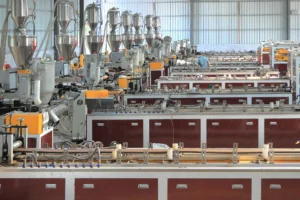Current Development of WPC Molds in China
WPC molds are essential tools in the production of wood-plastic composite products. With the increasing demand for environmentally friendly and high-performance materials, the development of efficient, precise, and durable molds has become a cornerstone of the WPC manufacturing industry. By leveraging advanced manufacturing techniques and design tools, China’s WPC mold industry is poised to lead in sustainable and innovative production.

WPC Mold Categories by Production Process
WPC molds vary depending on the production process and product type. The most common categories include:
1. Compression Molds
Compression molds are widely used for large-scale components such as automotive interior panels, ship partitions, and cabin boards. These molds offer high durability and precision, catering to industrial applications.
2. Injection Molds
Injection molds are used to create smaller, more intricate products like public seating, household appliances, and children’s toys. This method provides high efficiency and enables mass production.
3. Hollow Blow Molds
Products like pallets and packaging boxes are manufactured using hollow blow molding. This technique is ideal for lightweight yet durable structures.
4. Extrusion Molds
Extrusion molds dominate the WPC industry, accounting for over 60% of domestic WPC product manufacturing. They are used for producing flooring, profiles, doors, windows, and sheets, making them critical to the sector.
The Importance of Extrusion Molds in WPC Manufacturing
Extrusion technology plays a pivotal role in WPC production due to its ability to process a variety of natural fibers (e.g., straw, rice husks, wood flour) with polymer matrices. Let’s delve into the specific features of extrusion molds.
1. Design Innovations
Modern extrusion molds leverage advanced CAD/CAE tools to simulate production processes:
- Enhanced Precision: Simulations allow for accurate predictions of product performance and minimize errors during production.
- Streamlined Design Process: Transitioning from experience-based design to theoretical calculations ensures consistency and efficiency.
2. Structural Requirements
Extrusion molds consist of two primary components: the extrusion die and the calibration mold.
- Extrusion Die: Converts the molten WPC material from spiral motion to linear motion, ensuring even material flow and density. Proper design prevents issues like warping, high absorption rates, and uneven aging.
- Calibration Mold: Shapes and cools the material to its final form. Efficient heat transfer is vital for achieving smooth finishes and maintaining dimensional accuracy.
3. Challenges and Solutions
- Material Wear: WPC materials are highly abrasive, reducing the lifespan of molds to less than a year in some cases. Surface hardening and reduced friction techniques are being developed to combat this issue.
- Cooling Efficiency: Hollow mold designs face challenges in achieving uniform cooling. Innovations in heat transfer systems are critical to improving product quality.
Materials Used in WPC Mold Fabrication
High-quality molds are crafted using durable materials like:
- Stainless steel grades 2Cr13, 3Cr17, and 38CrMoAl.
- Advanced alloys such as H13 or imported DIN1.2316 steel. Post-processing treatments, such as heat treatment to a hardness of HRC55 or higher, ensure durability and precision.
Trends in WPC Mold Development
1. Technological Advancements
- Enhanced Simulation Tools: The integration of simulation software into the design process reduces development cycles and improves product consistency.
- Eco-Friendly Processes: WPC mold designs emphasize waste reduction, energy efficiency, and recycling, aligning with sustainability goals.
2. Industry Collaboration
The domestic market has seen a rise in specialized WPC mold manufacturers, driven by demand in construction, automotive, and consumer goods sectors. Collaborative efforts between material scientists and mold engineers are fostering innovation.
3. Government Support
Government initiatives promoting green building materials have further accelerated the adoption of WPC, indirectly benefiting the mold manufacturing industry.
Future Prospects
As WPC products gain popularity, the demand for high-quality molds will continue to rise. The development of wear-resistant materials, improved cooling technologies, and advanced CAD/CAE integration are expected to drive the next wave of innovation. Furthermore, the focus on recycling and circular economies ensures that WPC molds will play a significant role in sustainable manufacturing practices.

Conclusion
WPC mold development in China has progressed significantly, with advancements in extrusion, injection, and hollow molding technologies. These molds not only meet the growing demand for precision and durability but also support the shift towards sustainable and eco-friendly manufacturing. With continued innovation and industry support, WPC molds are set to redefine the production of high-performance composite materials, contributing to a greener and more efficient future.
Trending Reading
What Are the Differences Between the WPC Board and PVC Board?
[2024 Update] How Long Does WPC Decking Last?












